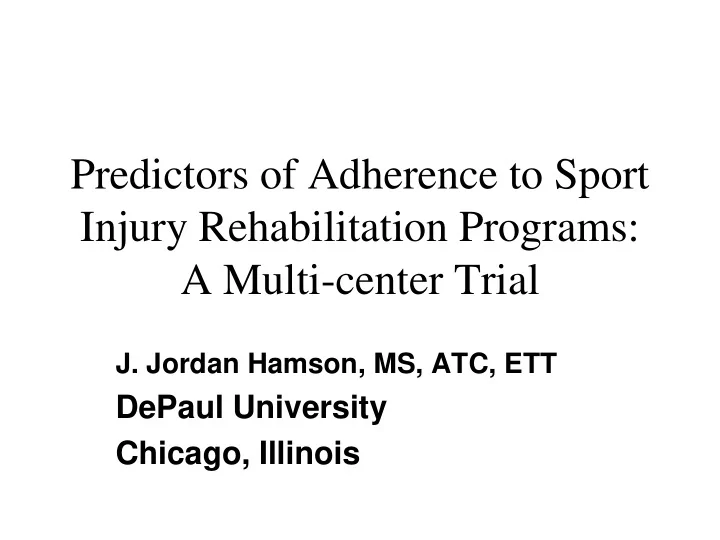

Predictors of Adherence to Sport Injury Rehabilitation Programs: A Multi-center Trial J. Jordan Hamson, MS, ATC, ETT DePaul University Chicago, Illinois
The Problem • Injured athletes not adhering to rehabilitation programs – adverse effect on rehabilitation goals – unfavorable rehabilitation outcomes – increased time missed from competition – depression & other mood disturbances
The Problem (cont.) • Many variables can influence rehab adherence – Over 200 (Meichenbaum, 1987) • Psychologically based issues relating to sports-injury are not well understood and have yet to be explained
Predictors of Adherence • Subject Level Variables – Social Support – Self-Motivation – Perceived Exertion – Pain Tolerance – Scheduling – Environment • Predictors were selected from previous research: Duda et al. (1989), Fisher et al. (1988), Byerly et al. (1994), Udry (1997), Fields et al. (1995) & Hamson & Sheu (in preparation)
Predictors of Adherence (cont.) • Clinic Level Variable – Patient Volume • Definition of Adherence – Adhere: attended all rehabilitation sessions – Non-Adhere: did not attend all sessions
Data Composition • 6 clinics in the Chicagoland area • Mixed sample of recreational & collegiate athletes – Male and female subjects • (39F, 55M, Ages 18-80 years) – Injury sustained from participation in sport – Rehab criterion: >=6 visits (6-51, mean=20.5) – Injuries included: knee(53%), shoulder(16%), ankle(15%), hip(6%) & back(10%)
Data Composition (cont.) • Instrument – Rehabilitation Adherence Questionnaire (RAQ) • 4-point scale (1-4) • 40 questions – pain tolerance (11), scheduling (6), environment (3), social support (10), perceived exertion (2), self-motivation (8) – Patient Demographic Survey • gender, age & athletic participation level – Attendance at rehabilitation sessions
Descriptive Statistics • Response Variables – Adherence Overall • Adhere (A) = 38 • Non-Adhere (NA) = 56 • Overall adherence rate = 40% – Clinic A NA Total Pt Vol • C1 12 7 19 147 • C2 4 8 12 305 • C3 5 11 16 298 • C4 8 8 16 57 • C5 6 8 14 192 • C6 3 14 17 251
Descriptive Statistics (cont.) • Predictors: Adhere vs. Non-adhere (ave) – Environment: 3.58 2.14 – Perceived Exertion: 3.12 1.85 – Social Support: 2.73 1.64 – Self-motivation: 3.30 2.02 – Pain Tolerance: 3.43 1.98 – Scheduling: 2.96 1.73
Sample Question from the RAQ Table 1. Sample Items from the Rehabilitation Adherence Questionnaire and Scoring SA A D SD Perceived Exertion: I nearly always (4) (3) (2) (1) work at 100% effort. Pain Tolerance: My rehab program (1) (2) (3) (4) was physically painful. Self-motivation: I enjoyed doing my (4) (3) (2) (1) rehab program. Social Support: I found rehab to be (1) (2) (3) (4) very lonely and isolating. Scheduling: My rehab program took (1) (2) (3) (4) up too much of my time. Environment: The training room (1) (2) (3) (4) makes me nervous. SA= strongly Agree A= Agree D= Disagree SD= Strongly Disagree
Hypothesis #1 • Predictors of adherence in the clinically rehabilitated recreational athlete will be: – Social Support – Self-motivation – Pain Tolerance • Listed in order of importance
Hypothesis #2 • The multi-center trial will reflect differences between the clinics in the following ways: – Patient Volume • Clinics with higher patient volumes will have higher non-adherence rates
Conclusion • 4 predictors composed a model to predict sport-injury rehabilitation adherence – self-motivation – pain tolerance – scheduling – patient volume (clinic level)
Conclusion (cont.) • Hypotheses Review – H1: not supported • Social support did not make the model • Scheduling makes sense in the clinical population – H2: supported • As the patient volume increases, adherence rates decrease • Class Size Theory (site this!)
Implications: Exercise Program Adherence The same set of predictors may shed light on why individuals don’t adhere to exercise programs: self-motivation, pain tolerance, scheduling Where does social support fit into this picture?
Future Research Direction • Additional predictors – Mood state – Level of Participation • Individual v. Team sport athletes – Golf v. Basketball • Differences in Gender • Cultural Differences – Asian athletes
Recommend
More recommend